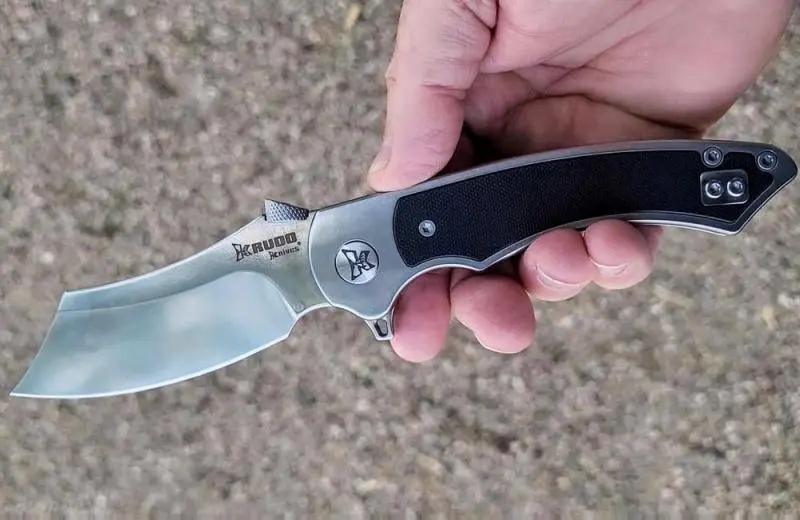If you’re an outdoorsman, survivalist, or tool aficionado, you may have heard of “clip point knife.” Why are clip point knives so popular? This guide covers clip point knives’ design, functioning, and uses. This article will teach you about clip point knives, whether you’re a knife collector or a novice.
What Is a Clip Point Knife?
Hunters, outdoor enthusiasts, and daily knife users love clip point knives for their unique shape. Its adaptable design features a blade with a concave spine and a fine, sharp point. The blade’s “clip”—the cut-out near the spine—gives it its characteristic look. Precision tasks benefit from this knife design.
The History of Clip Point Knives
Clip point knives originated in the US in the early 19th century. Bowie knives, named after American pioneer Jim Bowie, popularised the clip point design. This unusual design balanced fast stabs and smooth slicing, making it ideal for battle and practical use.
Key Features and Design
Clip-point knives have several distinguishing features:
Blade Shape: Clip point knives have a distinctive blade form. The blade’s spine is usually straight, but near the tip, it dips downward, creating a clipped or concave part. This trimmed part makes a sharp, fine tip, suitable for delicate and precise work.
Pointed Tip: Clip point knives have sharp tips for piercing. Detail work, carving, and precise cuts are ideal for it.
Large Belly: Clip point knives have a large belly, or curved cutting edge. The belly’s bigger slicing surface makes the knife ideal for chopping, slicing, and skinning.
Versatile Blade: The clip point blade may stab and slice. The belly cuts through diverse materials, while the clipped tip improves control and precision.
Clip Point Knife vs. Other Knife Types

To choose the right knife for your purposes, you must understand clip point knives’ unique traits. Clip point knives vs. popular knife designs:
Clip Point vs. Drop Point: Clip point and drop point knives are similar in many ways, but their blade forms differ. The clip point has a concave curvature and a fine, sharp tip, whereas the drop point has a convex curve and a larger, stronger tip.
Drop points are better for heavy cutting and survivability, whereas clip points are better for precision.
Clip Point vs. Tanto: Tanto knives have angular tips and straight cutting edges. Tactical and self-defense users prefer the tanto blade’s strength and penetrating power over the clip point. The clip point is more versatile and slicing.
Clip Point vs. Spear Point: The spear point blade is symmetrically curved with a sharp point in the centre, like a spearhead. The clip point is better for piercing due to its cut part.
Common Uses of Clip Point Knives

Clip point knives are useful for crafters and painters due to their accuracy and control. The clip point’s sharp tip and curved belly enable precise cuts and delicate shaping in carpentry, sculpting, and detailed details.
Survival and Emergencies: Clip point knives are crucial survival equipment. They can build shelters, cook, make fires, and give first aid.
Collecting and Knife Enthusiast: Knife collectors and aficionados love clip point knives. Collectors love clip point knives made by famous knife manufacturers with unusual designs and materials.
How to Choose the Right Clip Point Knife

To guarantee a clip point knife meets your needs, consider many things. Key considerations:
Blade Material: Choose durable and sharp blade materials. Damascus, high-carbon, and stainless steel are blade materials.
Handle Material: Comfortable and stable grip. Wood, G-10, Micarta, and metal handles are common.
Size and Weight: Knife size and weight affect portability and simplicity of use. A lightweight clip point knife is good for everyday carry, but a heavier one is better for certain jobs.
Locking Mechanism: Choose a folding clip point knife with a solid locking mechanism to secure the blade.
Budget: Determine your budget and examine choices within it. Quality materials and craftsmanship cost more.
Maintenance and Care Tips
Maintaining your clip point knife is crucial to its longevity and performance. Remember these tips:
Cleaning: After usage, clean your knife to remove dirt, debris, and moisture. Cleaning the blade and handle requires mild soap, warm water, and a soft cloth or brush. Avoid damaging chemicals and abrasives.
Drying: To avoid rust, dry the knife after cleaning. Dry the blade, handle, and moving parts.
Sharpening: Sharpen your clip point knife periodically. Use a knife sharpener or stone. Follow the manufacturer’s instructions or get professional help.
Lubrication: Lubricate the pivot point and other moving parts with a modest amount of lubricating oil or knife-specific lubricant. This prevents rusting.
Storage: Keep your clip point knife dry and secure. For safety, use a sheath or knife roll.
Common Questions
Who coined “clip point”?
The name “clip point” comes from “clipping” or curling the blade tip. This design adjustment makes it excellent for detailed jobs by sharpening the point.
Clip-point knives for self-defense?
Due of their sharp edge and versatility, clip point knives are good for self-defense. Self-defense tools depend on personal preference, local regulations, and the situation.
Clip-point knives for hunting?
Clip-point hunting knives are fine. Clip point knives can skin and dress game due to their curved belly and sharp point. However, blade length and size should match hunting tasks and local rules.
Clip point knife sharpening?
A knife sharpening stone or system can sharpen a clip point knife. If you’re unsure, consult the manufacturer or a specialist. To sharpen precisely, maintain a steady angle.
Clip-point knives—legal?
Your local laws determine whether clip point knives are legal. Before carrying a clip point knife, check local laws. It’s important to follow blade length, lock mechanism, and concealed carry laws.
Conclusion
Finally, clip point knives are adaptable and popular due to their blade shape and utility. Clip point knives are useful for hunters, outdoorsmen, and everyday carry. Its sharp, accurate tip and curved belly make it useful for detailed work and general usage.
Understanding essential characteristics, applications, and maintenance advice can help you choose a clip point knife that matches your needs.
